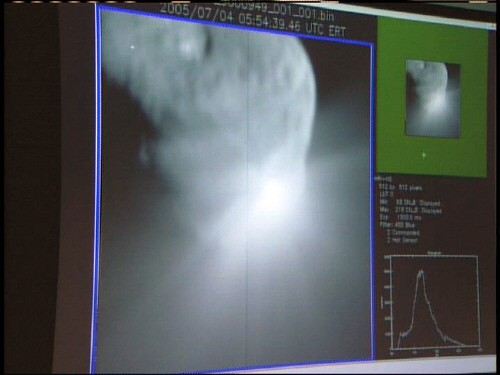NASA's "Deep Impact" probe successfully crashed into comet Tempel 1 at 06.52 GMT this morning -- the first time that a comet has ever been penetrated. The probe -- roughly the size of a washing machine -- was released by its mothership on Sunday morning after a 172-day journey from Earth, producing a large city-sized crater and a huge icy plume. Results sent back from the $333m mission will allow scientists to study the interior of a comet in more detail than ever before. The information could even shed light on how our solar system formed and how life on Earth developed.

Comets are the “undercooked leftovers” that remained after clouds of dust and gas condensed to form the Sun and planets some 4.5 billion years ago. Unlike other objects in the solar system, comets have barely changed with time and contain pristine material from the early days of the solar system. Composed of ice, dust and gas, they are often known as “dirty snowballs”. Some scientists believe that comets could have brought with them the carbon-based organic molecules needed to start life on our planet.
The first pictures of Deep Impact’s collision with Tempel 1, which took place in the outer reaches of the solar system some 133 million kilometres from Earth, showed clouds of dust and ice being ejected from the impact site (see figure). The impact was designed to disturb material inside the comet so that it could be analysed by the instruments on board the mothership, which include an infrared and a radio camera.
At the moment the collision took place, the flyby spacecraft was monitoring events from safe distance of 500 km from the comet’s surface. For the following 14 minutes the flyby collected data as the comet approached. Then it stopped collecting data and entered a defensive posture called “shield mode” where its dust shields protect the spacecraft’s vital components during its closest passage through the comet’s inner “coma”.
Space-based observatories, including the Hubble Space Telescope, the Chandra X-ray Observatory and the Spitzer telescope also monitored the event, together with many ground-based telescopes. Meanwhile, the European Space Agency’s own comet chaser, called Rosetta, surveyed the collision at a distance of 80 million kilometres from the crash. Rosetta will reach its target — comet Churyumov Gerasimenko (CG) — in 2014. The results from this mission will complement those obtained by Deep Impact.



